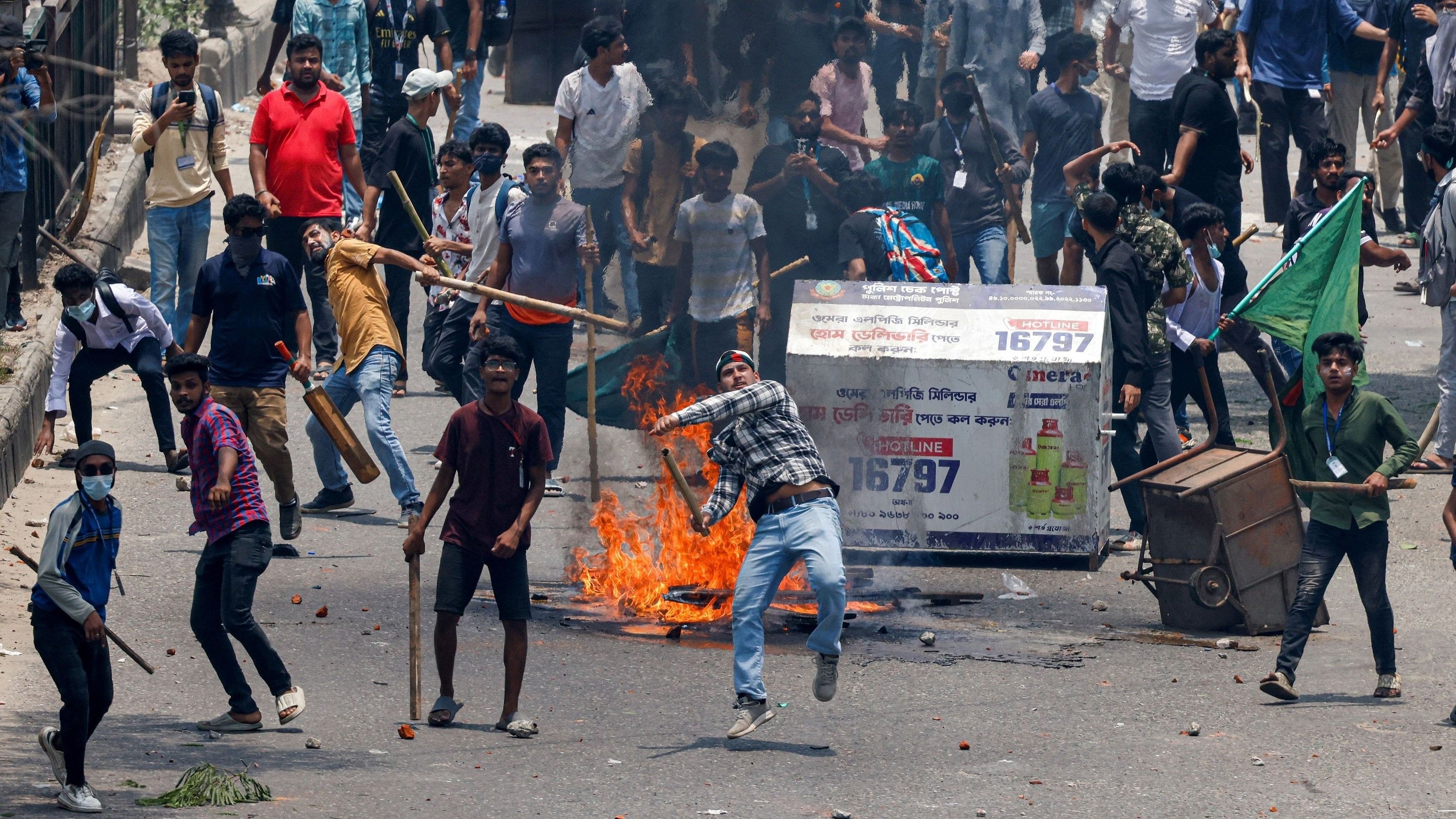
Protesters in Bangladesh.
Credit: Reuters Photo
By Andy Mukherjee
The collapse of a friendly government in Bangladesh is bad news for Prime Minister Narendra Modi. Most of India’s diplomatic relationships in South Asia are increasingly swaying to Beijing’s tune. But the significance of this week’s turmoil goes beyond geopolitics. Chaos at India’s eastern doorstep is also a warning to the bigger economy: The youth want employment, from politicians they can hold accountable. What they don’t want is jobless growth with democratic backsliding.
Bangladeshi Prime Minister Sheikh Hasina ultimately had to flee the country after deadly protests. People resented her autocratic rule, even though she had a solid economic track record, delivering 11 years of 5 per cent-plus growth in real per capita income since her return to power in 2009.
Modi, who just began a third five-year term, can lay claim to six such good years. Yet neither leader has managed to make a dent into the biggest challenge facing their youthful countries: unemployment. Covid-19 undoubtedly made the situation worse. But three years after the pandemic, disillusionment is setting in. A functioning democracy allows society to blow off steam via ballots. Boycotted by the opposition, elections held in Bangladesh earlier this year failed to provide that safety valve.
The turn of events should give India pause. Modi returned to power in June after securing a fresh mandate, though the loss of parliamentary majority for his party has at least partially opened one clogged democratic artery. It’s still early days, but the legislature seems to be working in a more spirited fashion than during the right-wing Hindu leader’s second term.
Still, all isn’t well. The state’s investigative and prosecutorial agencies are perceived by many to be targeting Modi’s political opponents and civil-society critics. Pre-poll surveys showed a sharp erosion of trust in the Election Commission. Violence against minorities, particularly Muslims, continues. Nor has the judiciary put a stop to “bulldozer justice,” under which some state governments are demolishing private property of people merely accused of crimes or encroachment on public land.
On the economic front, all that has changed is a tacit government acknowledgement that youth unemployment is a problem that’s not responding to trickle-down economics: It needs to be tackled directly with fiscal support. But will the plan to help 41 million youths with their first jobs and paid apprenticeships get off the ground before they lose hope in political authority?
The V-Dem Institute, a research unit at the University of Gothenburg in Sweden, categorizes both India and Bangladesh as “electoral autocracies.” Which raises the danger that the bigger neighbor might also be late in reacting to popular sentiment.
Credit: Bloomberg
Under its longest-serving premier, Bangladesh became the world’s second-largest exporter of textiles after China. India, which was on a skills-based, software-services-led path long before Modi’s 2014 arrival, aimed for more sophisticated production under him — from semiconductors to electric vehicles. Yet, for the youth in both countries, the outcome is roughly the same: In 2022, 30 per cent of Bangladesh’s 15- to 24-year-olds weren’t in employment, education or training. In India, the corresponding estimate for last year from the International Labor Organization is 23.5 per cent. Youth unemployment is at 16 per cent in both countries.
Bangladeshi college graduates are too well educated to work in textiles, while their counterparts in India are too numerous — and too underprepared — to be absorbed by modern industries looking for specialized talent.
With per capita gross national income of less than $3,000, both Bangladesh and India are stuck in the so-called middle-income trap. Neither is close to the club of rich nations, whose doors spring open only at about $14,000. The World Bank estimates that it would take the average Indian 75 years to get one-fourth as rich as the average American.
Much as they may like to have absolute power over their citizens, China’s single-party setup is not available to Indian or Bangladeshi leaders. They’re best served by lessons from South Korea.
A new World Bank report calls Korea’s economic history “required reading” for policymakers in middle-income countries. The government invested heavily in physical and digital infrastructure, while at the same time giving tax incentives to private firms that boosted research and development by an unprecedented 26 times between 1980 and 1990. Initially, Seoul preferred large conglomerates, and used them to raise the technology standards of local firms. When the chaebols became too powerful, Korea switched the focus of state support to entrepreneurs.
Although the stability that made the miracle possible was initially provided by authoritarian governments, the transition to democracy turned out well, too. In the last 20 years, Korea has climbed up the chart of economic sophistication — from 20th in the world to the third place. China is gaining ground in the kind of complex things it can make and sell. However, India’s ranking, close to China’s at the start of the millennium, hasn’t kept pace. Bangladesh is stuck behind 100 other countries.
The 10-fold increase in its stock of foreign capital since 2000 is a start for Bangladesh, but it needed political stability to deepen commercial engagement with the world. That process has come to at least a temporary halt in this week’s chaos.
India should read the right lesson from the upheaval. Attracted by its large domestic market, multinationals are willing to bring in technology and capital. But powerful local tycoons, who are themselves reluctant to invest in R&D, want to gird up against superior competition. India’s “stigmatized capitalism” might be standing between the youth and good jobs. If that is the case, then it’s time for Modi to correct his strategy.